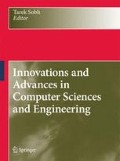Abstract
Based on the analysis and classification of identity factors in application systems, this paper designs a method of quantifying multi factors and an arithmetic of evaluation mechanism. It also adopts the example of application system to evaluate authentication intensity (means the degree of authentication, i.e. strong or weak authentication) and its cost. And the results of the application testify the method is applicable.
Access this chapter
Tax calculation will be finalised at checkout
Purchases are for personal use only
Preview
Unable to display preview. Download preview PDF.
References
Bolton, R. J., and Hand, D. J. Statistical Fraud Detection: A Review. Statistical Science Vol. 17, 3: 235-255. 2000
Patrick, A. Authentication Technology and Identity Theft. Unpublished manuscript, 01 Jun. 2007 http://www.andrewpatrick.ca/essays/authentication-technology-and-identity-theft/
Brainard, J., Juels, A., Rivest, R., Szydlo, M. and Yung, M. Fourth Factor Authentication: Somebody You Know. ACM CCS, 168-78. 2006
Retrieved from http://en.wikipedia.org/wiki/Authentication_factor
Brostoff S, Sasse A. Are passfaces more usable than passwords? A field trial investigation. In: McDonald S, editor. People and computers XIV—usability or else! Proceedings of HCI 2000. Berlin: Springer; 2000. p. 405–24.
Dhamija R, Perrig A. De′ja` vu: a user study using images for authentication. In: Proceedings of USENIX security symposium. Colorado: Denver; p. 45–58. 2000.
L. Hong and A Jain. Integrating faces and fingerprints for personal identification. Lecture Notes in Computer Science, (1351), 1997.
L Bahler, J Porter, and A Higgins. Improved voice identification using a nearest neighbour distance measure. In Proceedings Proc. International Conference of Acoustics, Speech and Signal Processing, pages 321–324, Adelaide., April 19-22 1994.
W. Zhao, R. Chellappa, P. J. Phillips, and A. osenfeld. Face recognition: A literature survey. ACM Comput. Surv., 35(4):399–458, 2003.
M Burger and W Burger. Using ear biometrics for passive identification. In G Papp and R Posch, editors, Proceedings of the IFIP TC11 14th international conference on information security, SEC’98, pages 139–148, Wien, 1998.
Lynne Coventry, Antonella De Angeli, and Graham Johnson. Honest, it’s me! Self service verification. In Workshop on Human-Computer Interaction and Security Systems, Fort Lauderdale, Florida, April 2003. ACM.
K Hayashi, E Okamoto, and M Mambo. Proposal of user identification scheme using mouse. In T Okamoto Y Han and S Qing, editors, Proceedings of the 1st International Information and Communications Security Conference, pages 144–148, 1997.
W G de Ru and J H P Eloff. Reinforcing password authentication with typing biometrics. In Proceedings of the IFIP TC11 eleventh international conference on information security, IFIP/SEC’95, pages 562–574, London, UK, 1995. Chapman and Hall.
W G de Ru and J H P Eloff. Enhanced password authentication through fuzzy logic. IEEE Intelligent Systems & their applications, 12(6), Nov/Dec 1997.
S Garfinkel, G Spafford, and A Schwartz. Practical UNIX and Internet Security. O’Reilly, Cambridge, 3rd edition, 2003.
Karen, R. . Quantifying the Quality of Web Authentication Mechanisms A Usability Perspective. 2003, http://www.dcs.gla.ac.uk/~karen/Papers/j.pdf
T Gilb. Advanced requirements specification: Quantifying the qualitative. In PSQT Conference St Paul MN, oct 1999. http://citeseer.ist.psu.edu/332850.html; http://www.pimsl.com/TomGilb/Quantify Quality paper PSQT.pdf.
T Moss. Web accessibility and uk law: Telling it like it is, July 2004. http://www.alistapart.com/articles/accessuk.
S Brostoff and A Sasse. Ten strikes and you’re out: Incresing the number of login attempts can improve password usability. In Workshop on Human-Computer Interaction and Security Systems, Fort Lauderdale, Florida, April 2003. ACM.
Author information
Authors and Affiliations
Corresponding author
Editor information
Editors and Affiliations
Rights and permissions
Copyright information
© 2010 Springer Science+Business Media B.V.
About this paper
Cite this paper
Xia, L., Yang, Y., Wang, Y. (2010). A Method of Evaluating Authentication Mechanisms. In: Sobh, T. (eds) Innovations and Advances in Computer Sciences and Engineering. Springer, Dordrecht. https://doi.org/10.1007/978-90-481-3658-2_31
Download citation
DOI: https://doi.org/10.1007/978-90-481-3658-2_31
Published:
Publisher Name: Springer, Dordrecht
Print ISBN: 978-90-481-3657-5
Online ISBN: 978-90-481-3658-2
eBook Packages: EngineeringEngineering (R0)

